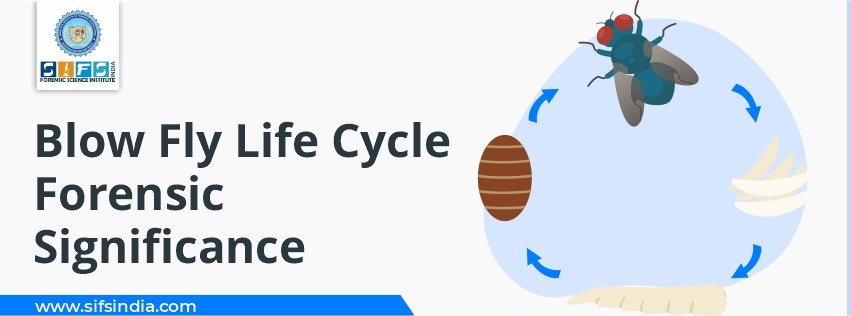- Call Us: +91 7303913002
- Email Us: education@sifs.in
Blow Fly Life Cycle | Forensic Significance

BY SIFS India | May 04, 2022
Blow Fly Life Cycle | Forensic Significance
Several kinds of insects feed on the decomposed body.
However, the most common of them all is blowflies and beetles. Flies especially blowflies, can detect the presence of the dead matter within minutes.
Most of the body’s decay results from getting eaten by fly larvae, also known as maggots. In comparison, beetles feed once the body has dried out.
For bodies lying dead for a longer duration, studying the blowfly life cycle in the dead body can be one of the most crucial clues for forensic investigators.
The flies quickly discover the corpse, and by studying their developmental times and the temperature of the surroundings, the time of death can be calculated.
The number of days is counted back from the development stage of flies living in the body.
Blow flies are an easy tool for entomologists to uncover the time of death. Let us now look at various development stages of the blowfly in the corpse.
What are Blowflies?
The blowflies belong to the Calliphoridae family and are also called scavenger flies. They are similar in appearance to the commonly found houseflies.
However, they are a little larger, have a big head and bulging eyes, and adult blowflies have a metallic appearance and might be blue, black, or green. These flies have almost similar feeding and breeding habits to house flies. The larvae of blowflies are known as maggots and have a tiny pale-worm-like look.
Blowflies do not bite humans but feed on decaying matter, wet garbage, rotten food, and decaying meat scraps. They flourish best in places having warm and humid environments.
Generalized Blow Fly Life Cycle
Blowfly Eggs Laying Stages
Female blowflies lay up to 150-200 eggs per batch. From laying eggs to hatching, the entire process takes around one day.
Larva - 1st Phase: The larvae feed on the body fluid and travel into the body. This stage takes around one day to complete.
Larva - 2nd Phase: In this stage, larvae roam around in worm form. A transition from the first stage to this is achieved in around one day.
Larva - 3rd Phase: The larvae still roam around in masses but are highly increased in size at this stage. It is a pre-pupa stage and takes approximately two days to reach.
Pre-Pupa: The pre-pupae move away from the body they were feeding to an appropriate pupation place, generally soil. They now get transformed into a pupa, and it takes around four days to reach from pre-pupa to pupa form.
Pupa: The pupae keep residing in the pupation site and transforms into adult flies. This development from pupa to adult fly takes around ten days to complete. Till this stage, from the time they moved to the pupation site, they do not feed.
Adult Fly: The adult flies mate on emerging from the pupa feeds on body fluids’ proteins, and lay eggs on the dead body. Emerging as an adult fly to laying eggs takes around two days.
Note: The development times mentioned here are generalized. Depending on the species and the temperature of the surroundings, they might increase or decrease.
More About Blow Fly Larva
Physical Distinctive Features
The main feeding stage of the fly is the larva stage. After hatching, the length of the larva is about 2mm, which grows to about 5mm before it sheds its skin to enter the second stage. It becomes about 10mm in length before shedding its skin to enter the third stage, where it grows to around 15mm-20mm before reaching the pre-pupa stage.
There is little distinction between the overall appearance of fly larva at different stages. The structure of the posterior spiracles through which the larva respires is used to identify larva of different stages.
Eating Habits
A fly larva is an eating machine. It has mouth hooks at the front end, which it uses to feed on decaying shredded flesh from the corpse. The anus and posterior spiracles are located in the chamber at the rear end. These spiracles assist the larva in breathing. Also, the position of the spiracles helps it to breathe, feeding throughout the day.
Larva has a muscular and segmented body that helps it easily turn on the corpse. And the presence of a simple intestine and a pair of large salivary glands help it in secreting digestive enzymes and spreading putrefying bacteria creating a soupy surrounding.
Intense Digestive Activities
The larva or maggot roams around in masses. The intense nature of its digestive activities results in immense heat generation. The body lying in the vicinity of the mass might get heat up to a high temperature, sometimes around 53 degrees Celsius.
Also, sometimes intense heat gets generated inside the mass that the larvae present in the center have to move to the edges to cool down. This heat increases the rate of digestion and putrefaction.
Final Words
Studying the blowfly life cycle is a great forensic investigation tool to calculate the time of death. However, it is not an easy process.
Several factors like temperature need to be considered during specimen collection by the investigators.
A dead body lying outside during the summer months for many days, the temperature surrounding the body can change severely.
Also, there are types of blowflies that develop faster in hot weather conditions than in the cold.
An entomologist must carefully observe the variations in the growth cycles in the specimen to identify a standard range.
It is a forensic science field that requires special training. So, if you feel inclined towards becoming an entomologist, do check out the professional forensic entomology course offered by SIFS India, a Govt. of India-recognized forensic science institute and laboratory.
